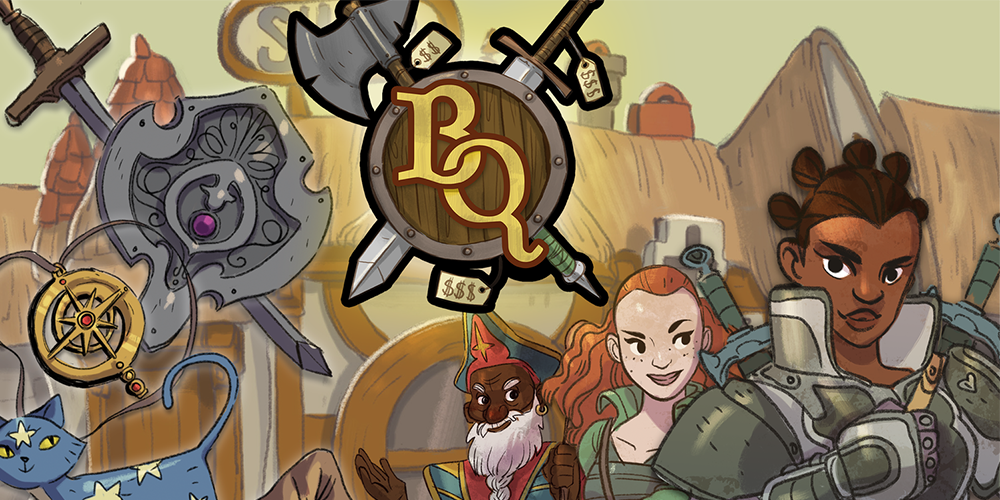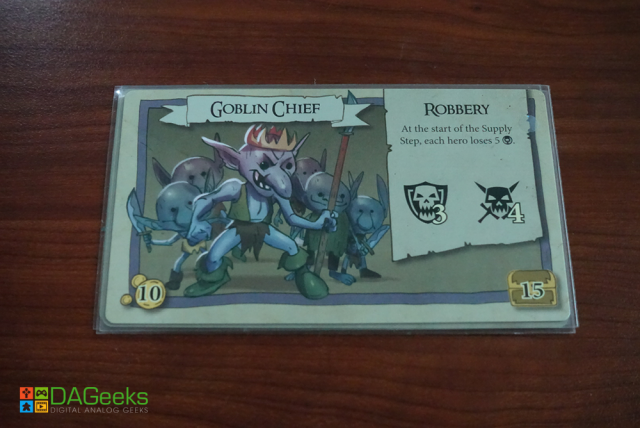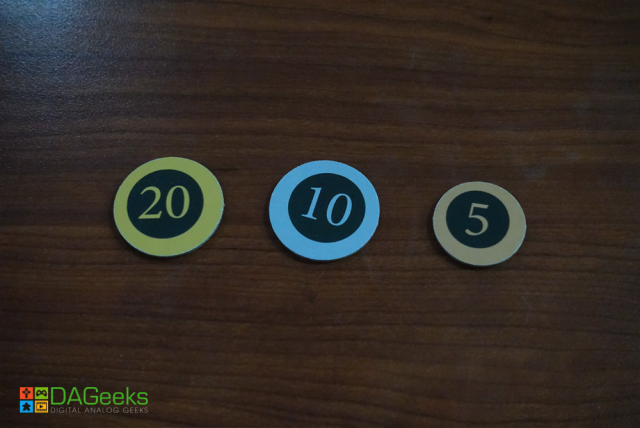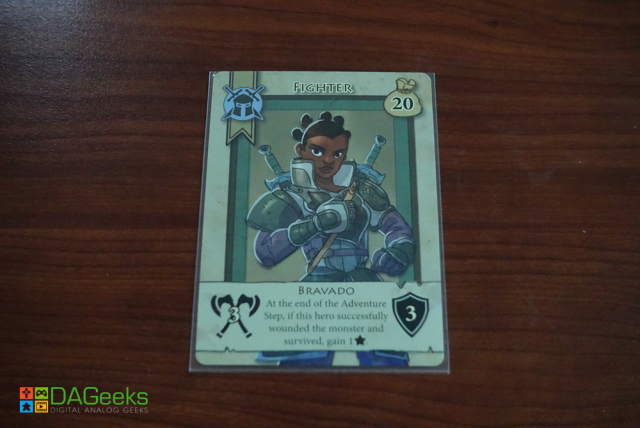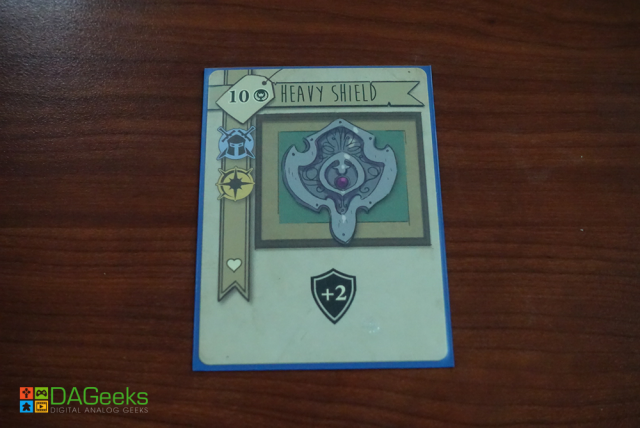In a world ravaged by Bandits, monsters, and dragons, heroes have stepped up to the plate. You will be selling them all you can to help, and maybe even that plate.
Bargain Quest is a card drafting game designed by Jonathan Ying, and illustrated by Victoria Ying for 2-6 players. Players will take on the roles of shopkeepers selling their wares to the heroes that have come to protect their town, but you don’t care about that, all you’re interested in is making a profit. The goal of the game is simple, get the most points either by making a huge profit or successfully helping the heroes in wounding the enemies, and surviving the waves.
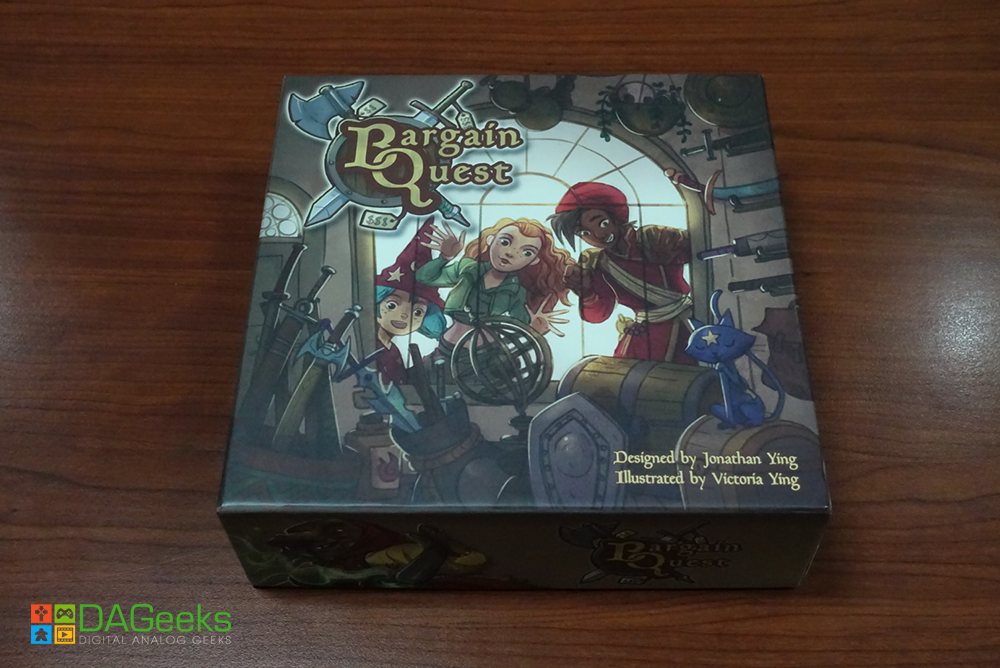
In a copy of the Bargain Quest base set I found:
- 112 Item Cards
- 16 Hero Cards
- 20 Employee Cards
- 12 Upgrade Cards
- 96 Coin Tokens
- 60 Star Tokens
- 10 Wound Tokens
- 1 Quest Token
- 12 Monster Cards
- 18 Adventure Cards
- 6 Folding Item Shop Boards
- Rulebook
The cards are made of good material, and doesn’t feel very prone to damage, with that said I still put them in sleeves since this game is heavily reliant on it. It also comes with cardboard tokens, and shop boards, which is my favorite of all the stuff in the box. The item shop board when folded on itself has the exterior of the shop printed on it, with the bargain quest logo on the other, open it up and players are greeted with the interior of the shop adding to the experience, giving opportunities for role playing and the like. Each of the boards are also made in different styles, making choice of shop even more fun, some go for the chinese shop and take on a persona, funnily enough the chinese shop won. The cards have simple layouts and the art is great, with easily recognizable icons, and symbols making for quicker plays. The art on the cards are wonderful as well, each item, and hero have their own distinct look, even the basic classes that have gender swaps had some preferred over others because of the art. All of these comes inside a pretty small box which is a plus for those that don’t have as much shelf space, It also makes a great display piece.
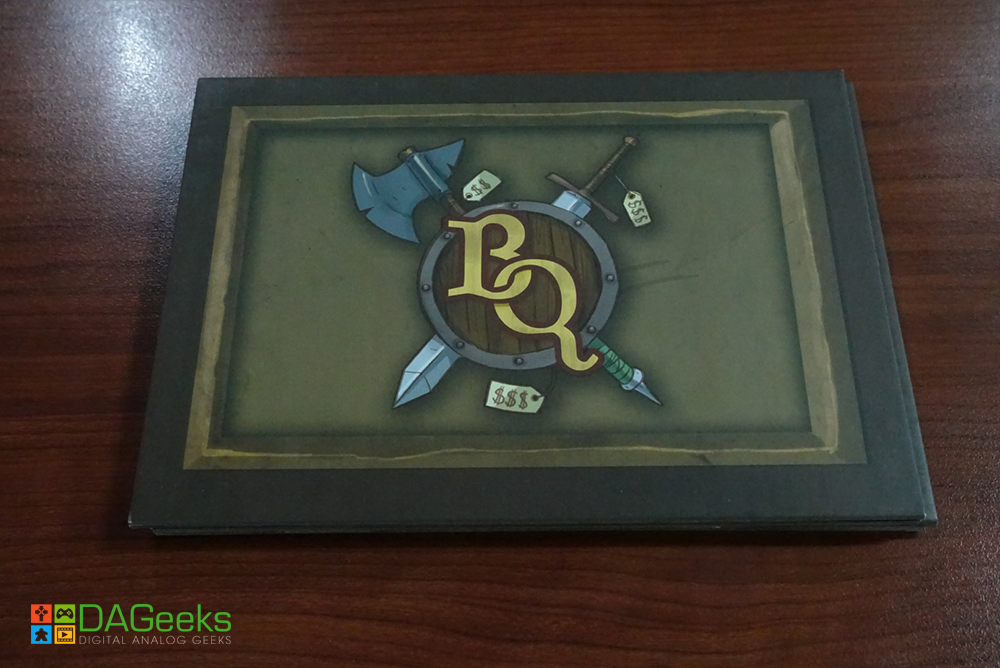
Setup is very easy. Each player is given a shop, and 5 coins. the cards are then shuffled and set in the middle where everyone can reach it easily. for the monster deck, just choose a card from each tier, and add it into the deck with the tier 3 monster at the bottom and the tier 1 at the top. 6 hero cards will also be revealed and given their corresponding purse amount, these will be the heroes players will try to attract into their shops. Last but not least the player who most recently purchased an item will be given the Quest token
The game itself has 6 phases a round; Supply, Display, Shopping, Adventure, Upgrade, Storage.
Supply
In the Supply phase, players are each dealt out 4 cards, simultaneously they will take 1 card from that hand and place it face down in front of them, signifying that item is in their shop, after which they will pass down the rest of the cards clockwise, and repeat the process until there are no more cards to pass around, it is also in this phase where the next monster in the deck is revealed. This is where the Supply phase ends.
Display
In the Display phase, players can now look at the hand of item cards they have drafted, and choose which item/s to put into their display, keeping in mind that they normally can’t sell these display items unless they have a special upgrade that allows them. Once everyone has finished, they all reveal their chosen display items, and it now moves onto the Shopping phase.
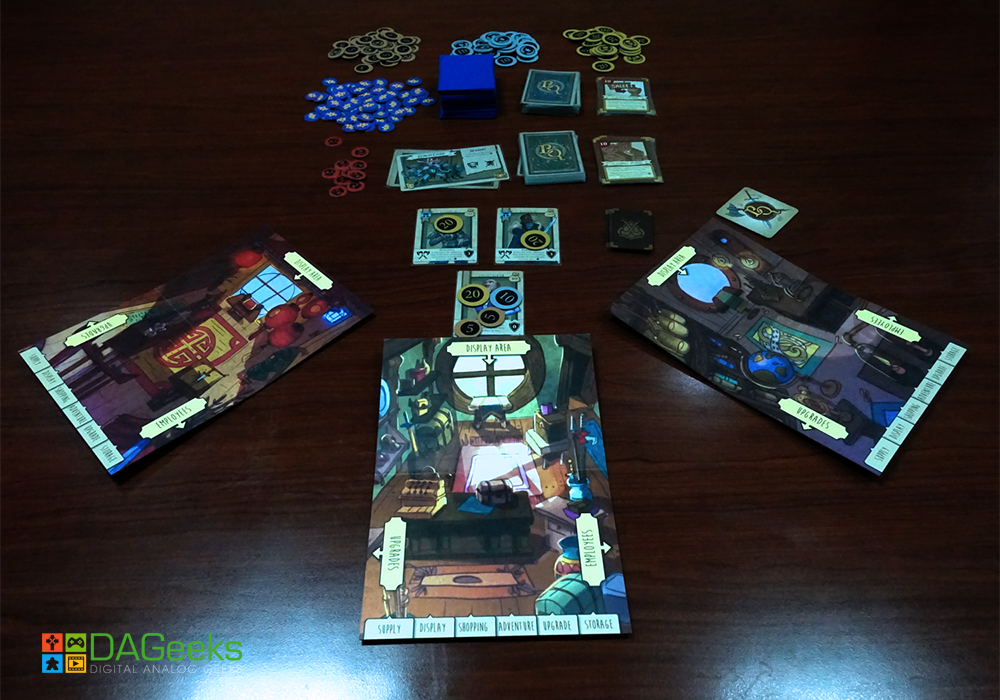
on the Item cards are certain elements players will need to keep in mind if they want to get the best bang out of their buck. Each item will have a cost, a list of icons(classes) that can use the item, hearts(attractiveness), and the stat boosts they provide.
Shopping
In the shopping phase the player with the highest revealed hearts gets to pick which hero they want to bring into their shop, but they can only choose a hero who has a class icon matching the display of their shop, if there is no hero that matches their item, then they are skipped, and it goes onto the player/s with the next highest. Ties in hearts are broken via the cost of the item they displayed, the player with the higher costing item will go first.
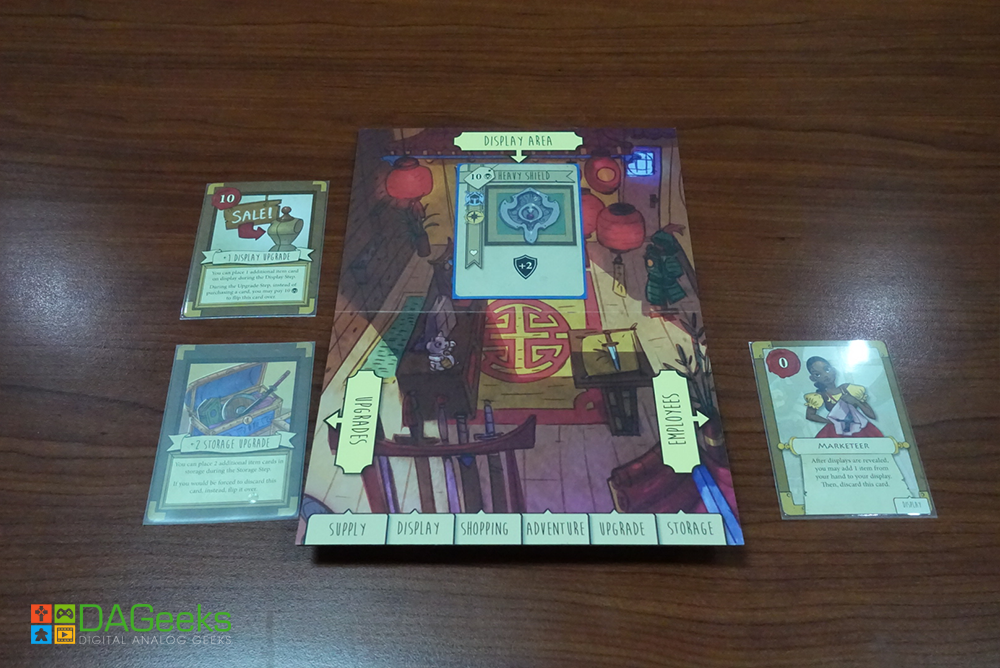
If there are no heroes left for you to attract to your shop, then you can choose from who is remaining, it is also during this time that the quest marker token is given to the player who picked last. Players can then sell them their most expensive useful item cards that weren’t put on display. As long as the hero has the money, and the class requirement, they can purchase it.
Adventure
After everyone has sold all the stuff they want/can sell to the heroes, they are then sent off to fight the enemy, but not before their individual quirks are revealed to us. In clockswise order starting from the player with the quest marker each hero is given an adventure card which can either make them totally awesome, or maybe forgetful and lose one of the items they bought. following the same order the heroes will fight the enemy, totalling these bonuses with the rest of the items and the hero’s own base stats it is then compared to the enemy. If the hero’s attack matches or exceeds the defense of the enemy, the monster is wounded, and the player who sold to them will get a star, which is kind of like a review on their store. Players will also receive stars if the hero survives the encounter when their defense matches or exceeds the enemy’s attack value. The enemy is defeated once it has gotten wounds equal to or more than the number of players. Should the hero die, don’t worry as you still have the memory of them and their lovely money that they left with you, also new suckers customers will be brought in to replace those who perished.
Upgrade
Starting from the player with the quest market, each player is given the opportunity to upgrade their store, or hire an employee to help them. Players can only get one. There are 2 upgrade cards in the game, the storage and display. Storage upgrade will let players keep more than 1 card at the end of the round, while display upgrades lets players display more than 1 item in their window.
Employees, while mostly are 1 time use cards, or part-time workers as I like to call it. Some can steal money from the adventurers that enter the shop, some can even run a hero that the shopkeeper doesn’t like out of town.
Once everyone has been given the chance to upgrade, this phase ends and the round moves onto the last, Storage.
Storage
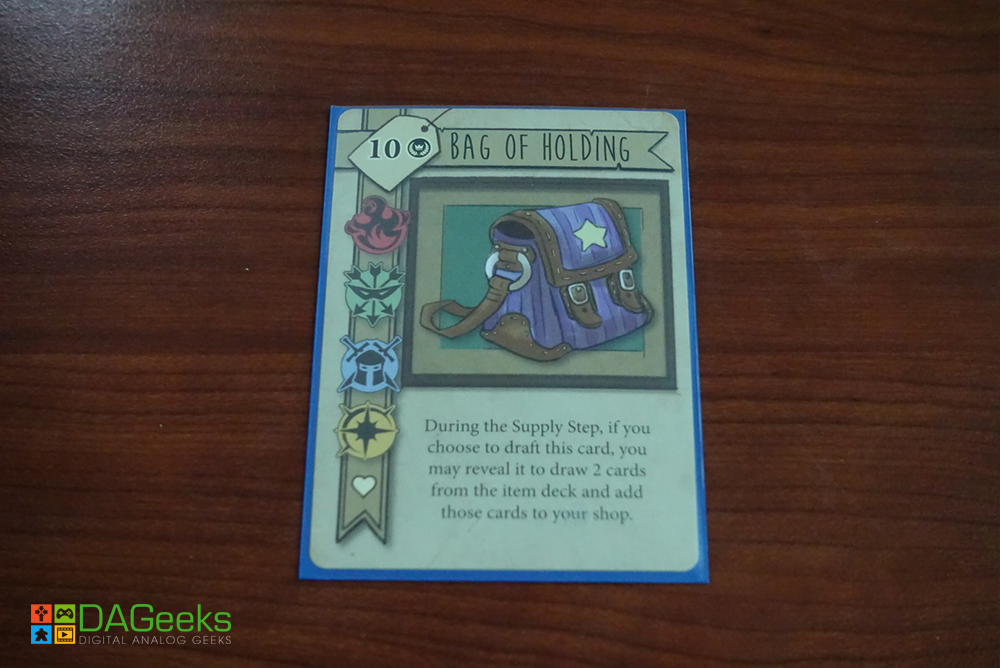
This is a fairly simple phase, each player will take all their cards, even the display item and choose 1(or more if they have the storage upgrade) item to keep for the next round. The rest are discarded, after which a new round is started, and 4 cards are dealt out again, keeping the stored card out of the drafting.
End
The game ends once all monsters have been defeated, or if there are no more hero cards in the deck when a hero is to be revealed. After the heroes have defeated all the enemies, players will then calculate their points, 1 for each star, and 1 for every 10 coins they have left. If there is a tie, the player with the most money wins the game.
Conclusion
The game is very fun, and easy to teach. Because of the iconography It isn’t a game heavily reliant on reading. I played the game with 4-6 players and its definitely a game they all enjoyed as well, at least that’s what I’ve been told. The cards are well designed with a bit of humor here and there, which is greatly appreciated since the premise of the game is already funny in and of itself. The game doesn’t go on too long either even with 6 players, unless someone gets 2 really good cards in one hand where they can’t decide what to get. With the simple addition, it makes it easy to teach kids/mathematically challenged adults. The adventure cards are a hit and miss for me, but then again there is the possibility of not using them at all, which makes this a minor problem for me, and while we’re on the topic of cards I felt there weren’t enough heroes and monsters and would have appreciated more of them in the base set instead of 16 heroes, and 12 monsters. The game can take up a lot of space on the table, and when the coins are added onto the heroes, it makes it hard to appreciate the artwork. All in all a great game, with a niche theme, that I think was well executed.


